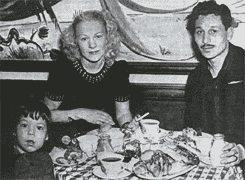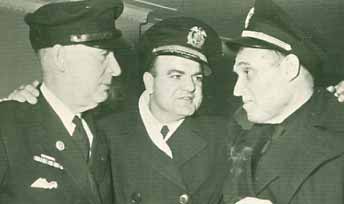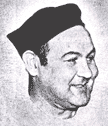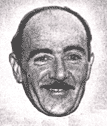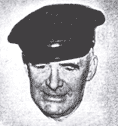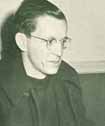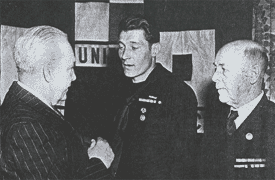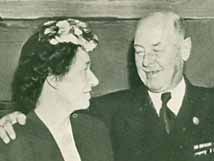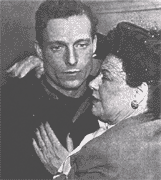POWs come home: The monotonous life in a prison camp ends for 42 Merchant Seamen repatriated from Germany
Mast Magazine, April 1945
[Additional photos from American Seamen: About Men of the Merchant Marine, Winter 1945]Mothers, wives, friends and sweethearts of 42 repatriated Merchant Seamen had waited patiently and hopefully for the return of these imprisoned men for almost three years -- but the last few seconds of this vigil were the most difficult.
They jammed the reception room of New York's Wilshire House, hotel for Merchant Seamen. They had waited all of a long afternoon for repatriates to arrive. There was a general feeling of tension and emotion. Apprehension was on every face as all waited for the news from a New Jersey pier.
The Gripsholm, Swedish exchange liner, had docked earlier in the afternoon [February 21, 1945]. Questioning by FBI, OWI [Office of War Information] and other government officials delayed the seamen's departure from the ship for several hours. Finally, officialdom was over. The men could leave. They packed their meager belongings into sea bags and small suitcases and word flashed back to the hotel that they were on their way. Women who had been calmly waiting for this moment began to cry and they swarmed into the lobby to await the first arrivals.
When the first repatriates arrived (they were brought in groups of ten), pent-up emotions broke bounds. It was a close race between newspapermen and relatives to see who could get to the seamen first. While some men were being hugged, kissed and interviewed, wives and sweethearts of others talked together nervously and excitedly. Doubts now arose in their minds. Is he really on the ship? Was he delayed again? Is he in a hospital? Some of the men were hospitalized and joined their families the following day.
This same scene was enacted several times as the men left the Gripsholm for the freedom they'd prayed for. In the reception room seamen were cornered by a dozen reporters; photographers found it difficult to fight their way through the throng of people to get their pictures and, off in a corner, while men were being kissed and hugged, women were weeping and bewildered seamen were being asked to pose and answer questions. A man was playing quiet dinner music on a piano in a vain attempt at making a generally confused situation more tranquil.
All of these Merchant Seamen had stories to tell. All had been in the prisoner-of-war camp at Milag Nord, near Bremen, for approximately two and one-half years. All had been torpedoed. Most of the captains had been held prisoner in German submarines. All of them agreed that "we'd never be here today if it wasn't for the Red Cross. Their food parcels saved us." And all wanted to sail again.
The men were in generally good spirits; in fact, they took the situation with more composure than did the gentlemen from the press and the relatives. Many of the relatives had come from as far away as New Orleans to meet a grinning seaman who had been behind barbed wire for two years.
Most of the seamen had been torpedoed on the Russian run and either landed their lifeboats and life rafts on the Norwegian coast or were picked up by submarines and German coastal craft. Some went immediately to Germany, others were put in solitary confinement and questioned for days by officials at Wilhelmshaven.
Praise for the American Red Cross was especially high. When questioned about the quality of their food at Milag Nord, one seaman said: "What food? Our regular parcels from the Red Cross kept us alive." The Red Cross also shipped to these men athletic equipment, books and other articles. The United Seamen's Service supplied them with uniforms and recreational equipment.
James Akins, Able Seaman from New Britain, Conn., said he also missed cleanliness. Their quarters, he said, were very poor and soap was a scarce commodity. "I would have also appreciated a soft chair," he added. Akins met his wife and two-and-a-half-year-old daughter, whom he saw for the first time, at the Wilshire House.
Reunion for James Akins, A.B. SS Carlton, and wife Virginia. Akins saw his daughter June Elaine for the first time. L-R: Walter Morrison, Chief Engineer, SS Stella Lykes; R. M. Peterson (affiliation unknown) Captain S. Charles Wallace, SS Stella Lykes
The men had lost a good bit of weight during their internment but regained part of the lost poundage on the Gripsholm.The seamen were all doubtful about their future. As repatriated Prisoners of War they are all pledged not to bear arms against Germany. "We'll do what the government wants us to do," was the general reply. All of the men questioned want to get back to sea as quickly as possible and several said they want "a crack at the Japs."
During their two-day stay in New York the men were entertained at a breakfast at the Andrew Furuseth Club, awarded Combat and Area Medals by Deputy War Shipping Administrator Edward Macauley, given a banquet at the Essex House, and were guests at the Broadway musical comedy, "Mexican Hayride."
Repatriates Tell Their Stories
The most unusual story told by any of the repatriates came from Captain Frederik Andersen Strand, master of the Matson Line ship Honomu, one of the first American vessels to be torpedoed on the "suicide" Murmansk Run early in 1942.
Left: Captain Frederik Andersen Strand, Master of SS Honomu
When the Honomu was hit by a U-boat she was in the Barents Sea, 350 miles from Murmansk. Taken aboard the submarine, Captain Strand was landed in Norway, the country of his birth.
"I was flown to Oslo," he said. "I told the German officers that I had a sister in Norway I had not seen since leaving the country 30 years ago. A meeting was arranged, but then we ran into further difficulty because she could not speak English and I could not understand Norwegian. However, my sister's husband acted as interpreter and we enjoyed a very pleasant visit.
Captain Strand was told by his sister that his father was living in Bodo and the German officers said the captain would be in Oslo several days and could see his father.
"That night, however," he added, "I was put aboard a German transport a few hours later and shipped to the prison camp. I learned later that my father came to Oslo to see me and died a short time later. I understand his disappointment over not seeing me was one of the contributing factors to his death."
At Camp Milag Nord, Captain Strand found that 5 members of his crew were also prisoners. The Captain is 36 years old and has been going to sea for 20 years. He joined the Matson Company in 1929 and received his first command in 1941. He reported that other survivors from his ship were rescued by Allied vessels and returned to the United States.
